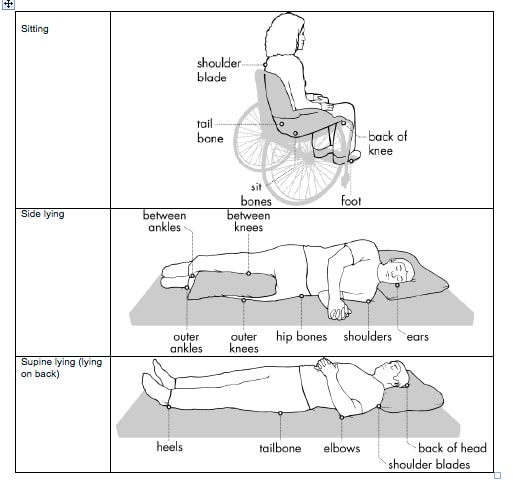|
Skin injuries caused by pressure For those of us caring for people who barely move or rely on others to move them, it is important to know how to best look after their skin. Pressure injuries, otherwise known as pressure areas, ulcers or bedsores, are among the negative effects of immobility. What is a pressure injury? A pressure injury is damage to an area of skin, usually around a bony part of the body, which has been under pressure for some time. The pressure stops the blood flow feeding the skin in the area and if the pressure is not removed the skin will break down and eventually become an ulcer. Friction from chaffing, or rubbing over these bony areas can also cause sores and ulcers. What areas are prone to pressure injuries? The diagrams below indicate where most pressure injuries generally occur, however people with unusual posture may develop them elsewhere. Who is likely to develop pressure?
Anyone who is immobile or can’t feel any sensations are at serious risk, especially those who:
How will I know someone is developing a pressure injury? The skin area around a bony part of the body may:
How can I prevent pressure injuries? A pressure injury is serious, can take a long time to heal, and many are preventable. We can help prevent pressure injuries by relieving direct pressure on the bony areas, taking good care of the skin and having a healthy diet and adequate fluids. Here are a few tips: Avoid direct pressure
Skincare
Diet
What should I do if you think a pressure injury is developing? Immediately reposition the person to completely take all pressure off the affected area and follow all the prevention tips above. Seek help from:
How can Therapy Professional’s Therapists can help? Our therapists can help with:
Dietitians: advise on:
Occupational Therapists: advise on:
Physiotherapists: advise on:
If you require education on prevention and management of pressure injuries, our friendly Physio and Occupational Therapists and Dietitians can help, just contact us at Therapy Professionals. Ph: 03 377 5280 Email: [email protected] Website: therapyprofessionals.co.nz Comments are closed.
|
AuthorShonagh O'Hagan Archives
July 2024
|


 RSS Feed
RSS Feed